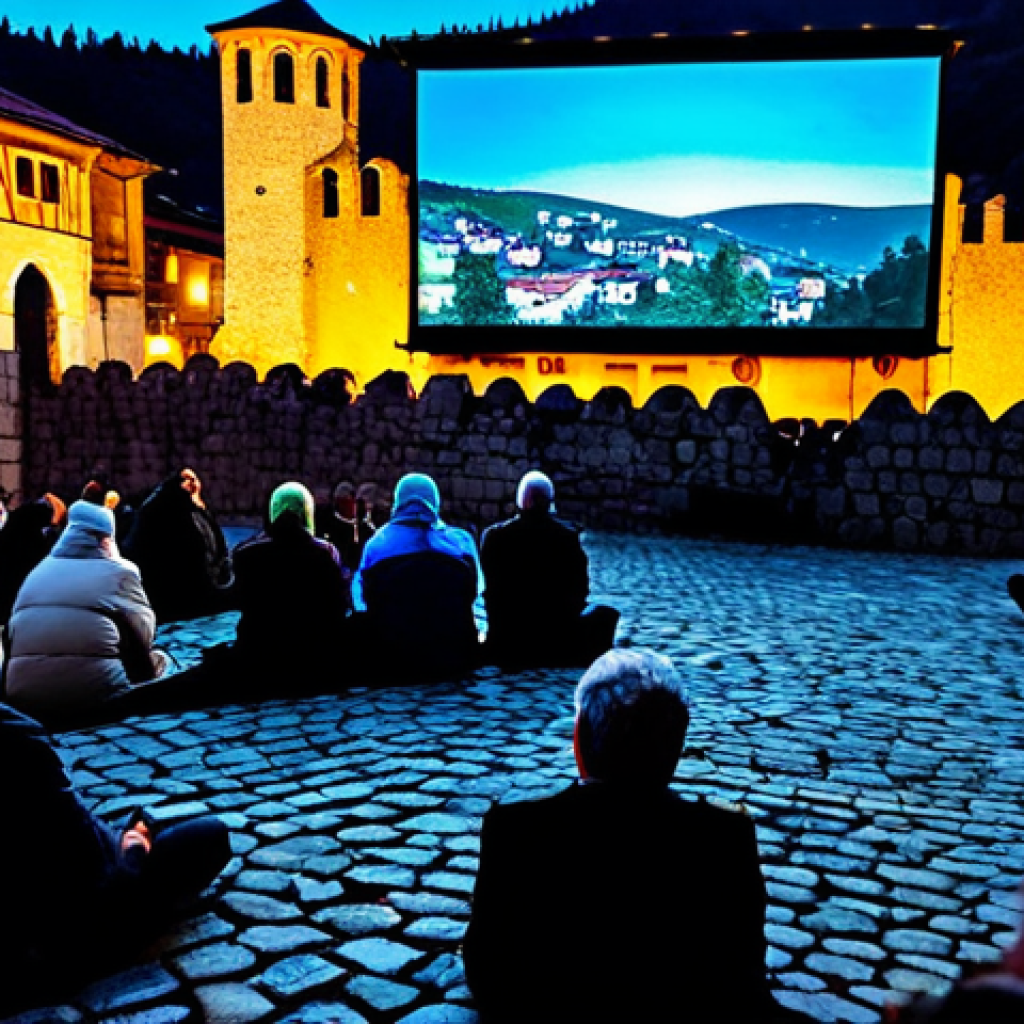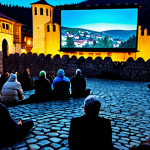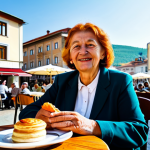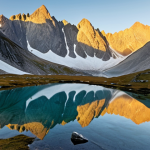Every time I think of Kosovo, my mind immediately jumps to its incredible, pulsating cultural scene. It’s not just about ancient history; it’s about a living, breathing artistic heart that genuinely surprised me on my first visit.
I distinctly remember strolling through Prizren during Dokufest, feeling that electric energy – filmmakers, artists, and locals all mingling, sharing stories, and pushing creative boundaries.
It’s a testament to how traditional roots can blossom into something cutting-edge and globally relevant, reflecting a nation’s vibrant identity. These aren’t just local gatherings anymore; I’ve seen firsthand how these events are increasingly leveraging digital platforms and global partnerships, evolving into powerful engines for cultural exchange and future innovation.
The way they seamlessly blend ancient traditions with modern artistic expressions, from contemporary music festivals to avant-garde theater, truly captures the essence of a nation confidently carving out its unique space on the world stage.
It’s a fascinating blend of the deeply personal and the universally appealing, showcasing Kosovo’s commitment to fostering creativity and dialogue, attracting diverse visitors and sparking conversations about identity, resilience, and what’s next for cultural landscapes worldwide.
Let’s explore it in detail below.
Beyond the Lens: Kosovo’s Cinematic Renaissance

When I first visited Kosovo, I was absolutely floored by how dynamic and potent its film scene was, particularly centered around events like Dokufest in Prizren.
It’s not just a festival; it’s an immersive experience that tells a profound story about a nation’s resilience and its deep desire to express itself creatively.
I remember walking through the cobblestone streets of Prizren, the ancient city walls illuminated by projections, and feeling this palpable sense of shared purpose among filmmakers, artists, and attendees.
It wasn’t about the red carpet glamour, but rather the raw, authentic storytelling that captivated me. The way they transformed historical sites into open-air cinemas, often under a blanket of stars, truly felt magical.
This unique approach, blending rich history with cutting-edge visual narratives, is something I haven’t quite experienced anywhere else. It’s a testament to how art can reclaim spaces and reshape perceptions.
The discussions I overheard and participated in were incredibly deep, reflecting on everything from post-conflict narratives to the future of independent cinema.
This isn’t just local talent, mind you; Dokufest has become a significant international platform, attracting global filmmakers and industry professionals, yet it retains that intimate, community-driven spirit that makes it so special.
It truly embodies the spirit of a community that believes in the power of visual storytelling to connect, to heal, and to inspire.
1. Dokufest: A Global Beacon for Documentary and Short Film
Dokufest is more than just Europe’s largest documentary and short film festival; it’s a cultural phenomenon that transforms the historic city of Prizren into a vibrant, open-air gallery and cinema for a week every August.
From the moment I stepped off the bus and saw the colorful banners draped across ancient stone bridges, I knew I was in for something unique. What struck me most was the sheer accessibility of it all – screenings weren’t confined to traditional theaters; they popped up in repurposed Ottoman-era hammams, medieval fortresses, and even on the banks of the Lumbardhi river.
This creates an incredibly intimate and memorable viewing experience, one that really blurs the lines between art and daily life. I recall watching a particularly moving documentary about environmental activism in a converted public bathhouse, the acoustics lending an almost sacred quality to the narrative.
The festival’s programming is incredibly diverse, tackling complex social, political, and environmental issues with a keen eye for human stories. It’s a place where emerging talents from the Balkans and beyond get a significant platform, and where seasoned filmmakers come to engage in truly meaningful dialogue.
Beyond the films themselves, the workshops, masterclasses, and Q&A sessions I attended were invaluable, providing insights into the craft and the industry from some of the most innovative minds today.
It genuinely felt like a hub where ideas were exchanged freely and collaborations sparked.
2. Nurturing New Voices: The Future of Kosovar Cinema
The energy around film in Kosovo isn’t just about the big festivals; it’s about a consistent, grassroots effort to nurture the next generation of storytellers.
I’ve been so impressed by the numerous initiatives and film schools that are springing up, providing young, aspiring filmmakers with the skills and resources they need to tell their own stories.
What’s really compelling is how many of these young talents are using film to explore contemporary Kosovar identity, often challenging stereotypes and offering nuanced perspectives on their country’s past, present, and future.
I had the privilege of meeting a group of film students in Pristina who were working on a collaborative project exploring the urban landscape of their city, and their passion was simply infectious.
They weren’t waiting for big budgets or external validation; they were creating, experimenting, and finding their voice with an incredible sense of urgency and authenticity.
It’s this kind of dedication that makes me so optimistic about the future of cinema here. Moreover, the local film commission has been instrumental in attracting international productions, which not only brings in revenue but also provides invaluable on-the-job training and exposure for local crews and actors.
This symbiotic relationship between local talent development and international collaboration is really setting the stage for Kosovo to become a significant player in the global film industry.
The Rhythmic Heartbeat: Music Festivals and Emerging Sounds
The moment the first bass drop hit at Sunny Hill Festival, I knew Kosovo’s music scene wasn’t just good; it was explosive. It felt like the entire city of Pristina was pulsating with an energy I’d rarely encountered.
This isn’t just about hosting international stars, although having Dua Lipa and other global artists on stage certainly adds an undeniable sparkle. For me, the true magic lay in seeing how these massive events have cultivated an environment where local talent can thrive, collaborate, and reach new audiences, both within Kosovo and internationally.
The crowd was a vibrant mix of locals and international visitors, all united by the sheer joy of live music. I vividly remember losing myself in a set by a local DJ who seamlessly blended traditional Albanian folk melodies with contemporary electronic beats – it was captivating and undeniably unique.
It was a moment where I truly understood that music here isn’t just entertainment; it’s a form of cultural expression, a celebration of identity, and a powerful bridge between generations and different backgrounds.
These festivals are more than just concerts; they are multi-day experiences that incorporate art installations, food stalls showcasing local cuisine, and pop-up markets featuring artisanal crafts, creating a holistic cultural immersion that encourages prolonged engagement and exploration.
1. Sunny Hill Festival: A Global Stage in the Balkans
Sunny Hill Festival, co-founded by global superstar Dua Lipa, has single-handedly put Pristina on the international music map. I’ve attended numerous festivals worldwide, and what makes Sunny Hill stand out is its incredibly vibrant atmosphere combined with a palpable sense of pride from the local community.
It truly feels like a homecoming for many, and the energy is absolutely electric. Walking through the festival grounds, I was struck by the seamless blend of global pop, hip-hop, and electronic music with powerful performances by Albanian artists from Kosovo, Albania, and the diaspora.
It’s a masterclass in cultural synergy. Beyond the headliners, I always make it a point to explore the smaller stages, where emerging local bands and DJs get their moment in the spotlight.
I discovered some incredible rock and indie acts that I wouldn’t have otherwise, and it really underscored the depth of talent within the region. The festival also invests heavily in local infrastructure and talent, providing jobs and opportunities for countless young people, from stage crew to event organizers.
It’s not just a party; it’s an economic and cultural engine, drawing in tourists who then spend time exploring the wider country, boosting local businesses and creating a tangible ripple effect throughout the economy, ensuring that the positive impact of such events extends far beyond the final note of the last song.
2. Alternative Sounds and Underground Scenes
While major festivals grab headlines, Kosovo’s music scene thrives on a rich tapestry of alternative and underground movements that I find incredibly compelling.
From the gritty, independent rock bands playing in small clubs in Pristina’s ‘Qafa’ area to experimental electronic artists pushing boundaries in converted warehouses, there’s a raw, unadulterated creativity here that truly excites me.
I’ve spent countless nights exploring these smaller venues, discovering incredibly talented musicians who are creating sounds that defy easy categorization.
There’s a strong DIY ethos, where artists are often producing, recording, and distributing their own music, driven purely by passion. I remember stumbling upon a live performance by a jazz fusion band in a tiny, smoky bar, and I was absolutely mesmerized by their improvisation and the sheer musicality on display.
It felt like I was witnessing something truly authentic and on the cusp of breaking out. These scenes are vital for fostering innovation and providing a platform for voices that might not fit into mainstream narratives.
They often tackle challenging themes through their lyrics and compositions, reflecting the socio-political landscape in a way that is both cathartic and thought-provoking.
This underground ecosystem is the true incubator for future stars, proving that Kosovo’s musical vibrancy extends far beyond just one or two big names.
Weaving Stories: Traditional Crafts and Artisanal Heritage
Stepping into a traditional artisan workshop in Gjakova felt like walking back in time, yet with a vibrant, living pulse. The scent of wood, wool, and natural dyes filled the air, instantly transporting me.
It was a profound reminder that Kosovo’s cultural narrative isn’t just about modern expressions; it’s deeply rooted in the hands-on mastery of generations.
I’ve always been drawn to places where ancient traditions are still practiced with reverence, and Kosovo certainly delivers. The intricate patterns woven into the traditional (a distinctive Albanian folk dress) or the delicate filigree work of silver jewelry tell stories of identity, resilience, and artistic dedication.
I vividly recall watching an elderly woman meticulously weave a traditional rug, her fingers moving with a practiced grace that spoke of decades of experience.
She explained to me the symbolism behind each color and motif, and it wasn’t just a craft demonstration; it was a lesson in history and cultural preservation.
These crafts aren’t just decorative items; they are tangible links to the past, embodying the collective memory and aesthetic sensibilities of a people.
I saw how many local artisans, particularly women, are using these skills not only to preserve heritage but also to create sustainable livelihoods, adapting traditional techniques to contemporary designs that appeal to a global market.
1. The Art of Filigree and Silver Craftsmanship
The filigree workshops in Prizren are an absolute marvel, and if you get a chance, you must visit one. The sheer dedication and precision required for this ancient art form are breathtaking.
I watched a master artisan, his hands steady and precise, manipulating tiny silver threads into intricate patterns, creating pieces that looked like delicate lace spun from metal.
He told me stories of how this craft has been passed down through his family for generations, a secret language of shapes and forms. The history of filigree in this region dates back centuries, reflecting Ottoman and Byzantine influences, yet contemporary Kosovar jewelers are breathing new life into it, blending traditional motifs with modern designs.
I ended up purchasing a small, exquisitely crafted silver pendant – not just because it was beautiful, but because it felt like I was taking a piece of living history home with me.
The process itself is mesmerizing: melting the silver, pulling it into incredibly thin wires, and then painstakingly twisting and soldering these wires into complex, often floral or geometric, patterns.
It’s a testament to patience and artistry. These pieces are not just jewelry; they are miniature sculptures, each one unique, carrying the imprint of the artisan’s skill and the cultural heritage they represent.
2. Weaving Tradition: Textiles and Carpets
The tradition of hand-weaving is incredibly strong in Kosovo, particularly evident in the vibrant patterns and textures of its carpets and textiles. I was fascinated by the stories behind each design, many of which carry deep symbolic meanings passed down through generations.
I visited a small cooperative where women were reviving old weaving techniques, creating stunning (flat-woven rugs) and (pile carpets) that are both practical and works of art.
The use of natural dyes, often derived from local plants, results in a rich, earthy palette that feels incredibly authentic. What truly impressed me was the dedication of these artisans, often working on traditional looms for hours on end, transforming simple threads into masterpieces.
I learned that the geometric patterns often represent elements of nature, historical events, or even family lineage. These aren’t just decorative items for tourists; they are integral to Kosovar homes, cherished as heirlooms.
Many of these weaving centers also serve as vital community hubs, especially for women, providing economic independence and a space to share skills and stories.
It’s a beautiful example of how cultural preservation can empower communities and ensure that these invaluable skills continue to flourish in the modern world.
| Event/Institution | Primary Focus | Location | Typical Season | My Personal Takeaway |
|---|---|---|---|---|
| Dokufest | International Documentary & Short Film Festival | Prizren | August | Incredibly atmospheric screenings in historic sites; a true blend of art and urban space. |
| Sunny Hill Festival | International Music Festival (Pop, Hip-Hop, Electronic) | Pristina | August | Electric energy, world-class acts, and a powerful showcase of local Albanian talent. |
| Prishtina International Film Festival (PriFest) | Feature Films, Film Industry Development | Pristina | September | A vital platform for Balkan cinema and a hub for film industry networking. |
| Chopin Piano Fest Pristina | Classical Piano Music | Pristina | April-May | Showcases exceptional classical talent in a surprisingly vibrant classical music scene. |
| Prizren City of Culture | Traditional Crafts & Heritage Preservation | Prizren | Year-round efforts | Witnessing artisans, especially silversmiths, preserving ancient, intricate techniques. |
Stages of Expression: Theatre and Performing Arts’ Bold Narratives
The theatre scene in Kosovo might not always make international headlines, but let me tell you, it’s brimming with raw talent and a fierce determination to tell powerful stories.
My first experience at a local theatre in Pristina was utterly captivating. The stage wasn’t just a platform for entertainment; it felt like a vital space for dialogue, for confronting difficult truths, and for celebrating shared humanity.
I distinctly remember a contemporary play that tackled themes of memory and reconciliation with such nuance and emotional depth that it stayed with me for days.
The actors were incredibly passionate, conveying complex emotions with remarkable intensity. It struck me that theatre here is often deeply rooted in the country’s recent history, serving as a powerful medium for collective healing and critical reflection.
Yet, it’s not solely about the past; there’s also a vibrant experimental scene that’s pushing boundaries, challenging conventions, and exploring universal human experiences through innovative theatrical forms.
The audiences are incredibly engaged, often staying for long post-performance discussions, highlighting the crucial role theatre plays in the cultural and intellectual life of the nation.
1. National Theatre of Kosovo: A Hub for Contemporary Drama
The National Theatre of Kosovo in Pristina stands as a cornerstone of the country’s performing arts landscape, and it’s a place I always make sure to visit when I’m in the capital.
It’s not just an institution; it’s a living, breathing testament to the power of dramatic expression. The repertoire is incredibly diverse, ranging from classic plays to bold, contemporary works that often challenge audiences and provoke thought.
I’ve seen performances there that seamlessly blend traditional storytelling with modern theatrical techniques, creating something truly unique and compelling.
What impresses me most is the theatre’s commitment to fostering local talent, providing a platform for Kosovar playwrights, directors, and actors to hone their craft and showcase their work.
I had the opportunity to speak with one of the theatre’s resident directors, who passionately explained how their work often serves as a mirror to society, addressing complex social issues and encouraging public discourse.
The energy within the theatre on a performance night is palpable; you can feel the audience’s anticipation and their deep connection to the stories being told on stage.
It’s a place where history, emotion, and contemporary narratives converge, making every visit a profoundly enriching experience.
2. Independent Theatre and Experimental Performances
Beyond the established institutions, Kosovo’s independent theatre scene is a vibrant hotbed of experimentation and innovation. This is where you find the most daring and boundary-pushing work, often performed in unconventional spaces – from repurposed industrial buildings to intimate art galleries.
I’m always on the lookout for these grassroots performances because they offer a raw, unfiltered glimpse into the creative pulse of the nation. I recall attending an experimental performance art piece in an old factory that used immersive soundscapes and interactive elements to explore themes of urban decay and renewal.
It was challenging, thought-provoking, and utterly unforgettable. These independent groups are often driven by a fierce passion and a desire to connect with audiences on a deeper, more personal level, unburdened by commercial constraints.
They’re a testament to the resilience and resourcefulness of Kosovar artists, who often create impactful work with limited resources, relying on ingenuity and collective effort.
This underground movement is crucial for the ongoing evolution of the performing arts, providing a space for new voices to emerge, new forms to be explored, and new dialogues to be initiated, ensuring the scene remains fresh, relevant, and captivating.
A Taste of Tradition: The Rich Tapestry of Kosovar Cuisine
You simply cannot talk about a culture without savoring its food, and Kosovo’s culinary scene is a delightful journey for the senses. My first meal in Pristina, a plate of (a layered pancake-like dish baked under a traditional metal dome), was an instant revelation.
It wasn’t just food; it was a warm embrace, a story told through flavor and texture. What struck me immediately was the emphasis on fresh, locally sourced ingredients and time-honored cooking methods passed down through generations.
Eating in Kosovo feels deeply personal, almost like you’re being welcomed into someone’s home. I distinctly remember sitting in a small, family-run restaurant in Peja, the aroma of simmering stews and freshly baked bread filling the air, and feeling an incredible sense of comfort and authenticity.
The conversations I had over meals were some of the most memorable parts of my trip, revealing so much about the local way of life and the pride they take in their culinary heritage.
It’s a cuisine that’s hearty, comforting, and packed with flavor, reflecting the region’s agricultural abundance and its historical crossroads. Every dish tells a tale of the diverse influences that have shaped the country, from Ottoman to Balkan traditions, creating a truly unique gastronomic identity.
1. Staple Dishes and Local Delicacies
Kosovar cuisine is built on a foundation of simple, wholesome ingredients transformed into incredibly flavorful dishes. Beyond , which you absolutely must try, there’s (a baked lamb and rice dish with a yogurt topping) that will completely redefine your comfort food standards – the rich, tangy sauce and tender meat are a perfect match.
I was also incredibly fond of (grilled minced meat sausages) served with fresh onions and (a roasted red pepper and eggplant relish), a staple that you’ll find everywhere, each place doing it slightly differently.
Don’t even get me started on the variety of (flaky pastries filled with meat, cheese, or spinach); I could eat it for every meal. What makes these dishes so special isn’t just the recipe, but the love and care that goes into preparing them.
Many restaurants still use traditional wood-fired ovens, imbuing the food with a distinct, smoky flavor that you just can’t replicate. And the bread! Freshly baked, often still warm from the oven, it’s perfect for soaking up every last bit of sauce.
Exploring the local markets, seeing the seasonal produce, and then experiencing how those ingredients are transformed into these incredible dishes provides a profound understanding of the local culture and its deep connection to the land.
2. The Culture of Coffee and Hospitality
Beyond the main meals, the coffee culture in Kosovo is an experience in itself, and it truly embodies the warmth and hospitality of the people. It’s not just about getting a caffeine fix; it’s a ritual, a social cornerstone.
I quickly adopted the habit of starting my day with a strong, small cup of Turkish coffee, often served with a glass of water and a sweet treat. The process of brewing, with the tiny (copper pot) slowly simmering on the stove, is almost meditative.
But it’s the social aspect that truly shines. Coffee shops, or , are bustling hubs of activity where people gather to chat, share news, and simply enjoy each other’s company for hours on end.
I remember sitting in a packed in Pristina, the air thick with conversation and the clinking of tiny cups, feeling completely at ease despite being a foreigner.
It was a beautiful example of how simple pleasures can foster strong community bonds. And when you visit someone’s home, you’re almost always offered coffee first, a symbol of welcome and respect.
This deep-rooted tradition of hospitality, centered around a shared cup of coffee, is one of the most endearing aspects of Kosovar culture, making you feel instantly connected and truly part of the local fabric.
Empowering the Future: Youth-Driven Cultural Initiatives
One of the most inspiring aspects of Kosovo’s cultural landscape, for me, has been witnessing the sheer energy and innovation emanating from its young population.
This isn’t a country resting on its historical laurels; it’s a nation where youth are actively shaping the future, often through incredibly creative and proactive cultural initiatives.
I’ve seen firsthand how young artists, activists, and entrepreneurs are taking matters into their own hands, creating spaces, platforms, and movements that are redefining what culture means in Kosovo.
It’s a powerful statement of self-determination and an incredible testament to their resilience. There’s a palpable sense of urgency and optimism among young people, a desire to contribute positively to their society and to connect with the wider world.
Whether it’s through urban art projects that transform neglected spaces into vibrant murals, or through digital platforms that amplify unheard voices, the youth are truly at the forefront of a cultural renaissance.
Their initiatives often address contemporary social issues, promote dialogue, and foster a sense of community, proving that culture can be a powerful tool for social change and youth empowerment, creating a dynamic and forward-looking society that values innovation and fresh perspectives.
1. Urban Art and Public Spaces Transformed
Walking through the streets of Pristina, you can’t help but notice the explosion of vibrant street art and murals that have transformed otherwise drab walls into captivating canvases.
This isn’t just graffiti; it’s a deliberate movement by young artists to reclaim public spaces and infuse them with color, meaning, and often, political commentary.
I spent an afternoon simply wandering, discovering new murals around every corner, each one telling a unique story or conveying a powerful message. It felt like an open-air gallery, constantly evolving.
I learned that many of these projects are organized by youth collectives who are passionate about using art to beautify their cities, spark conversations, and even challenge traditional norms.
They’re often funded through crowdfunding or small grants, demonstrating an incredible level of initiative and community engagement. These murals aren’t just aesthetically pleasing; they serve as visible symbols of artistic freedom and a testament to the youthful spirit that refuses to be confined.
They bring life and character to urban areas, attracting both locals and tourists to explore neighborhoods they might otherwise overlook, contributing to a more dynamic and engaging urban experience.
2. Digital Platforms and Youth Voices Amplified
In a world increasingly connected by technology, Kosovar youth are leveraging digital platforms to amplify their voices and share their cultural expressions with a global audience.
This has been a game-changer, allowing them to bypass traditional gatekeepers and directly connect with like-minded individuals and communities worldwide.
I’ve been incredibly impressed by the number of youth-led online magazines, podcasts, and video channels that are emerging, covering everything from contemporary art and music to social commentary and environmental activism.
These platforms provide a crucial space for young people to express themselves freely, experiment with new media, and engage in critical dialogue. I follow several Kosovar Instagram accounts that showcase emerging artists and designers, and it’s inspiring to see how they’re building communities and gaining international recognition.
This digital fluency is not just about entertainment; it’s about creating new avenues for cultural exchange, challenging stereotypes, and presenting a nuanced, modern image of Kosovo to the world.
It proves that despite being a small nation, its youth are global citizens, actively contributing to the digital cultural landscape and forging connections that transcend geographical boundaries.
Bridging Worlds: Digital Innovation in Kosovo’s Cultural Scene
The dynamic interplay between tradition and technology in Kosovo’s cultural sector is genuinely fascinating, and it’s something I’ve seen evolving rapidly.
It’s not just about preserving the past; it’s about leveraging cutting-edge digital tools to make culture more accessible, engaging, and globally relevant.
I’ve witnessed how museums are embracing virtual reality, how festivals are livestreaming performances to reach wider audiences, and how artists are using digital art forms to express themselves in new and exciting ways.
This forward-thinking approach, particularly among the younger generation, is truly impressive. It shows a clear understanding that while heritage is vital, innovation is key to staying relevant and attracting new audiences.
The speed at which they adopt and adapt new technologies to tell their stories and showcase their talents is remarkable. This isn’t just about cool gadgets; it’s about creating new avenues for participation, learning, and cultural exchange, ensuring that Kosovo’s rich heritage and vibrant contemporary scene can be experienced by anyone, anywhere, breaking down geographical barriers and fostering a more inclusive cultural landscape that champions both the old and the new.
1. Virtual Experiences and Digital Archives
I’ve been particularly impressed by how cultural institutions in Kosovo are embracing digital solutions to make their collections and heritage more accessible to a global audience.
Imagine being able to virtually explore ancient archaeological sites or intricate museum exhibits from your living room! This isn’t just a futuristic concept here; it’s becoming a reality.
I’ve seen impressive initiatives involving 3D scanning of historical artifacts and creating immersive virtual reality tours that allow visitors to experience cultural landmarks in unprecedented detail.
This is incredibly important for preservation, especially for fragile artifacts, but also for education. Students and researchers from around the world can now engage with Kosovo’s rich history without needing to travel.
These digital archives are also a powerful tool for cultural diplomacy, allowing Kosovo to share its unique narrative and heritage with a wider international audience.
It’s a proactive approach to ensuring that cultural knowledge is not confined by physical borders or the passage of time, making it available for future generations to explore and appreciate, and ensuring that cultural legacy remains vibrant and accessible to all who seek it.
2. Online Platforms for Artistic Collaboration and Promotion
The digital space has become an incredibly fertile ground for artistic collaboration and promotion in Kosovo, particularly for independent artists and cultural organizations.
I’ve observed countless instances where artists are using social media, specialized online platforms, and even NFTs to connect with their peers, share their work, and reach new markets.
This democratizes the art world, allowing talents from smaller towns to gain visibility and build international networks that might have been impossible just a decade ago.
I’ve seen local musicians gaining significant followings on platforms like YouTube and Spotify, and visual artists selling their work to collectors overseas directly through their online portfolios.
It’s a testament to their entrepreneurial spirit and adaptability. These digital tools aren’t just for showcasing finished work; they’re also facilitating collaborative projects, with artists from different cities or even countries working together remotely on music, film, and art installations.
This digital connectivity is fostering a dynamic and interconnected cultural ecosystem, proving that geographical distance is no longer a barrier to creativity or collaboration, and solidifying Kosovo’s position as a forward-thinking hub for artistic innovation in the digital age.
In Closing
My journey through Kosovo’s vibrant cultural scene truly left an indelible mark on my soul. It’s a country that defies easy categorization, weaving together ancient traditions with a fierce, forward-looking spirit, all powered by the incredible energy of its people.
From the electrifying stages of Dokufest and Sunny Hill to the quiet, meticulous work of filigree artisans, and the profound narratives unfolding in its theatres, Kosovo offers an immersive cultural experience unlike any other.
It’s a place where every corner holds a story, every meal is an invitation, and every interaction reveals a deep-seated pride and resilience. If you’re seeking a destination that offers authenticity, innovation, and an unbelievably warm welcome, look no further than Kosovo.
Useful Information
1. Currency: The official currency in Kosovo is the Euro (EUR). ATMs are widely available in cities and larger towns, and credit cards are accepted in most hotels, larger restaurants, and shops, though cash is preferred for smaller transactions, especially in local markets.
2. Best Time to Visit: For cultural festivals like Dokufest and Sunny Hill, August is the prime month. Spring (April-June) and early Autumn (September-October) offer pleasant weather for exploring cities and historical sites, with fewer crowds.
3. Getting Around: Major cities are well-connected by an affordable and efficient bus network. Taxis are readily available in urban areas. For exploring more remote cultural sites or the countryside, renting a car can offer greater flexibility, but note that road quality varies outside main routes.
4. Language: Albanian is the official language, and Serbian is also recognized. However, a significant portion of the younger population, especially in Pristina and other tourist hubs, speaks excellent English, making communication relatively easy for international visitors.
5. Hospitality: Kosovar people are renowned for their exceptional hospitality. Expect to be offered coffee, food, or assistance frequently. Embracing these gestures of welcome will enrich your experience and connect you more deeply with the local culture.
Key Takeaways
Kosovo’s culture is a dynamic blend of deep-rooted traditions and cutting-edge innovation. Its film, music, and performing arts scenes are vibrant, driven by youth and a spirit of resilience.
Traditional crafts like filigree and weaving showcase exquisite artistry, while the cuisine offers hearty, authentic flavors. Digital innovation is making its rich heritage and contemporary expressions globally accessible, ensuring Kosovo’s unique story continues to be told and experienced.
The warmth and hospitality of its people are truly unforgettable.
Frequently Asked Questions (FAQ) 📖
Q: What exactly makes Kosovo’s cultural scene feel so “pulsating” and uniquely vibrant, from your firsthand perspective?
A: Honestly, it’s not just a buzzword; it’s a palpable energy you can feel the moment you step foot there. I distinctly remember wandering through Prizren during Dokufest, and it wasn’t just about the films – though they were incredible – it was the entire atmosphere.
Filmmakers, local artists, and even just regular folks were all intermingling, sharing stories, genuinely excited about what was happening. It felt like every street corner held a spontaneous performance or a deep conversation.
It’s a place where creativity isn’t confined to galleries or stages; it spills out into the streets, into the cafes. That raw, authentic enthusiasm, that feeling of a living, breathing artistic heart, is what truly makes it pulsate.
It’s not just about what you see, but what you feel – a collective passion for expression.
Q: How does Kosovo manage to so seamlessly blend its ancient traditions with cutting-edge, modern artistic expressions, and why is this blend so significant?
A: This is precisely where Kosovo’s cultural genius lies, in my view. They don’t see tradition as something to be preserved in a museum, but as a rich foundation to build upon.
Think about it: you might hear a DJ effortlessly weaving ancient Albanian folk melodies into a contemporary electronic set, or see a traditional narrative reimagined through a completely avant-garde theatrical performance.
It’s not about abandoning the past; it’s about a confident, almost playful reinterpretation. This fusion is incredibly significant because it speaks volumes about the nation’s identity – resilient, deeply rooted, yet forward-looking and globally aware.
It allows them to present a unique cultural narrative that is both deeply personal and universally appealing, resonating with audiences worldwide who appreciate both heritage and innovation.
Q: Beyond drawing visitors, how are Kosovo’s cultural initiatives and their increasing global partnerships truly impacting its future and its standing on the world stage?
A: What I’ve observed is that these initiatives are doing so much more than just attracting tourists; they’re fundamentally reshaping Kosovo’s global image and fostering innovation.
By aggressively leveraging digital platforms and forging powerful international partnerships, these events have evolved into genuine engines for cultural exchange.
They’re not just showcasing local talent; they’re inviting the world in, sparking vital conversations about identity, resilience, and the very future of cultural landscapes everywhere.
When you have international filmmakers, musicians, and artists collaborating and sharing their work in Kosovo, it positions the nation as a proactive contributor to global cultural dialogue.
It demonstrates a commitment to fostering creativity and open discussion, effectively carving out a unique and respected space for Kosovo on the world stage, not just as a consumer of culture, but as a dynamic, innovative producer.
📚 References
Wikipedia Encyclopedia
구글 검색 결과
구글 검색 결과
구글 검색 결과





